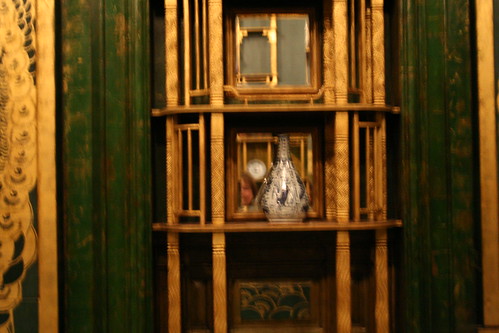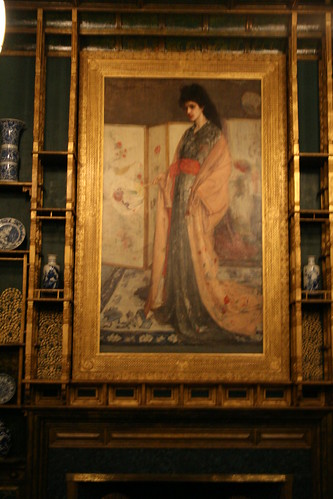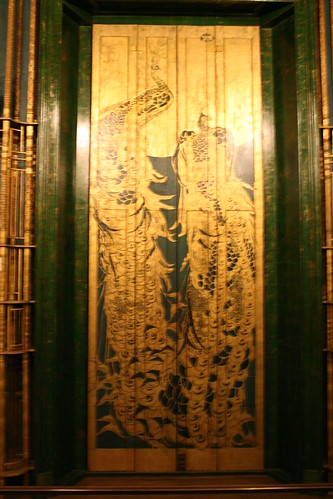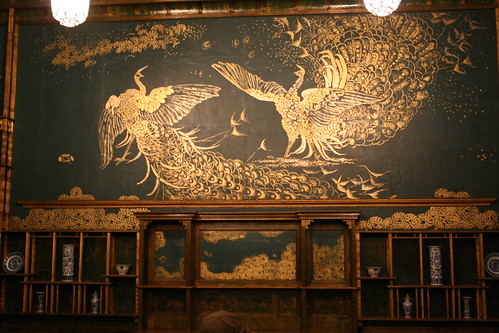May 11 2006
Harmony in Blue and Gold: The Peacock Room – James McNeil Whistler
While my folks and my brother were in town, we managed to go into DC and see some sights. My favorite, which I’ve seen many many times, and always see again when I go into DC for siteseeing, is James McNeil Whistler’s The Peacock Room.
I think the history of the room is why I like it so much.

Whistler’s patron, Leyland, was redecorating his dining room, mainly he wanted more shelving on which to display his porcelain collection. Whistler’s painting, “The Princess from the Land of Porcelain” was hung over the fireplace, and the designer consulted the painter about whether a certain color on the walls would clash with the painting. Whistler asked permissiong to retouch the walls, which Leyland agreed to.

Then Leyland went out of town, and in his absense, the creative spirit overtook Whistler, and he really went to town on the room, making all sorts of changes and embellishments, like putting gold leaf on the ceiling and painting the shutters over the windows with beautiful plumed peacocks.

Well, he told Leyland about the changes and added that it wasn’t done yet, and not to come back home until it was finished – all the while he brought his friends and even the press through the room to show it off. Leyland was kind of miffed, because he had only agreed on the minor changes and wasn’t prepared for the additional cost of these embellishments, which he hadn’t even signed off on. When it came time to pay for the painter’s work, Leyland voiced his displeasure, and finally agreed to pay for HALF the total Whistler wanted for payment, and then to add insult to injury, he paid him in pounds, instead of guineas. A pound is worth 20 shillings, and is considered the a tradesman’s currency, while payment to artists is usually made in guineas, which is worth 21 shillings.
Obviously, Whistler was upset and insulted by the quibbling over money for his fabulous work of art, and so he took the liberty of adding even more embellishments to the room. A large mural was painted on the wall opposite The Princess, and he depicted two peacocks in a fighting stance. One of the peacocks had feathers sticking out along it’s neck, which points him out as representing Leyland, and the ruffled shirts he always wore. He is in a position of dominance over the other peacock, and has coins scattered at his feet, showing the money that Leyland did not want to pay. The other peacock had a feather sticking up from his head, which was similar to a lock of Whistler’s hair (cowlick maybe?).

(The only photo that actually looks in focus! Wowee!)
He also made other changes to the room, taking the valuable leather hangings and painting them a brillian prussian blue, which I suppose could be considered ruining them. The sad part is that the painter never saw his room again, after he finished.
The room was bought and passed through several hands before it came to Charles Lang Freer, who left it to the Smithsonian upon his death. I beleive it had to go through some major rennovation at this point, as it had been taken apart and put together so many times.
It makes me happy to go sit in the Peacock room and look around, it is so beautiful. But it also makes me sad. Obviously, it is good that it is in a museum so that so many can look at it and enjoy it, but it still saddens me. I wonder about the parties that Leyland must have thrown in the room when it was in his house, and the comments that must have been made about it’s ornate embellishments. I wish I could see it back then, with the shutters thrown open and sunlight flooding in, the door to the kitchen opening and closing with servants bustling food and plates in and out. What would the colors look like with the daylight shining in? In the musuem, it is very dark, obviously the low light protects the room, but I just wish I could see how it would be, functioning as a normal room, with people sitting down to dinner, or milling around with a cocktail in one hand. Leyland telling the story about the room, and what his guests must have thought of it all. I can’t help thinking that Leyland probably got a good deal of enjoyment out of telling the story, since he kept it just as it was for twelve years (until he died). I wonder if years later, after the sting had left the situation, if he was sorry he hadn’t paid Whistler the full price asked. I bet he got his money’s worth out of the story alone.
Now that I’ve told you the story as I remember it, I found a link that has the official story – be sure to read it, as I have omitted some of the details (glad to see I got a good bit of it right, though 🙂 ) Also, their pictures are much better than my fuzzy-low-light ones. And I hope next time you’re in DC, stop by the Freer Gallery and have a peek into the Peacock room. I always do 🙂

One Response to “Harmony in Blue and Gold: The Peacock Room – James McNeil Whistler”

Very nice! Will have to check this out when in DC next.